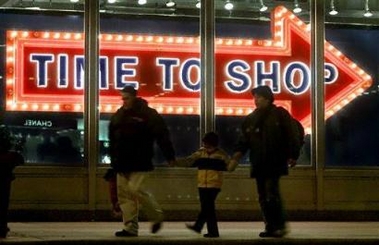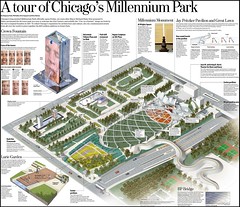Renaissance of Chicago's "Loop" shows the value of quality public investment
 Pedestrians walk past a store window display along State Street on Monday, Nov. 28, 2005, in Chicago. (AP Photo/Jeff Roberson)
Pedestrians walk past a store window display along State Street on Monday, Nov. 28, 2005, in Chicago. (AP Photo/Jeff Roberson)DC1974 calls our attention to an article in today's Chicago Tribune about the resurgence of the Chicago's "Loop." The article, "Loop lights up with a retail wick: Rebounding from decades of decline, the Loop has dusted itself off and is undergoing a renaissance as a magnet for tourists, shoppers and other spenders--and taxpayers--drawn to stores, theaters, rest," demonstrates the importance of coordinated and focused investment, and "destination development"--in this case both the revitalization of extant assets as well as the creation of a new asset--the $475 million Millennium Park, which is now perhaps the #1 destination in Chicago, and a magnet for vitality in the downtown core, plus housing. From the article:
Real estate experts confirm what has become increasingly apparent: There is a bona fide retail renaissance taking shape in the Loop, one of Chicago's oldest and best-known destinations but one that was long ago left behind as other areas, especially north of the Chicago River, flourished with restaurants and shopping.
Thanks in large part to a $60-million investment to revive the theater district and $475 million spent to build Millennium Park, a record number of retailers and restaurants are moving into the Loop looking to benefit from the influx of tourists, residents and students who hang out downtown long after offices have closed.
"It's definitely paid off," said Allen Joffe, principal broker at Chicago-based Baum Realty Group Inc., a real estate firm tracking the Loop's retail revival.
The Loop retail market posted a banner year in 2005, with 89 new leases signed, topping the previous record in 2004 of 60, according to an annual study from Baum Realty. That's almost triple the 34 leases signed in 2003, Joffe said.
What's more, the gross average asking rent rose 10.3 percent, to $58.52 per square foot a year in 2005, from $53.04 in 2004. The 2005 rate was the highest since the firm began tracking rents eight years ago.
 The Chicago Tribune's special online section about the Park is available here. (Registration is required.)
The Chicago Tribune's special online section about the Park is available here. (Registration is required.)More from the Loop article:
Retailers had avoided the Loop for decades, particularly State Street, the city's first major shopping district. The street lost cachet to North Michigan Avenue in the 1970s and then chased away traffic when it was closed to autos from 1979 to 1996 in an ill-conceived attempt to create a pedestrian-friendly outdoor shopping mall. As recently as 2004, retail vacancies for specialty stores on State Street surpassed 20%, according to Northern Realty Group Ltd. That figure dropped to 4.6% last fall.
Claudia Martin, who moved to an office building turned condo in the heart of the Loop five years ago, has watched the transformation from her living room. "We used to joke you could lie down in the street on a Saturday afternoon and no one would run over you," said Martin.
Now, fast-food lunch spots are staying open later and on the weekends. Tanning salons and dry cleaners are hanging up shingles. And fashionable restaurants and shops are starting to move in. ...
Much of the Loop's rebirth can be traced to Millennium Park's opening two years ago. Held up as a model use of urban public space, the free concerts, stunning architecture and gardens attract an estimated 3 million visitors a year. Priceline.com named Millennium Park the most requested travel destination this summer, according to a study of the top 50 summer travel destinations, released in June.
"The transformation is phenomenal," said Chris Holtebeck, a tourist from Appleton, Wis., who has watched Chicago change. "There's just so much to see. And I feel safe."
Some parents feel the same way. It's not unusual to find Kregg Kaducha pushing a stroller around the Loop after 8 p.m., something he wouldn't have considered before the redevelopment took place. His sons, ages 2 and 5, run up and down the terraced stairs at the newly opened Wabash Plaza along the Chicago river and gaze at skyscrapers.
Also see "ONE YEAR LATER The Millennium Park effect: It has emerged as a sparkling example ... of how big cities can get big things done," by Blair Kamin.
Check out more than 9,000 photos on Millennium Park via Flickr.
Index Keywords: urban-revitalization



0 Comments:
Post a Comment
<< Home